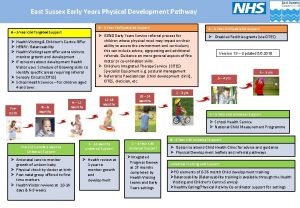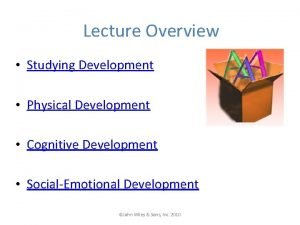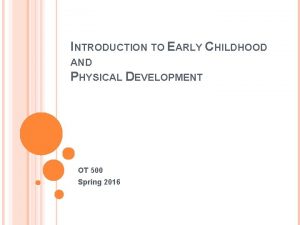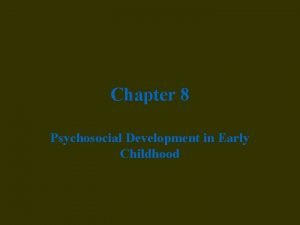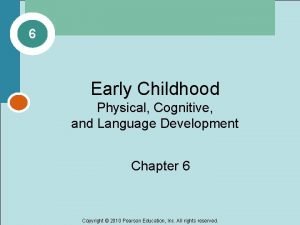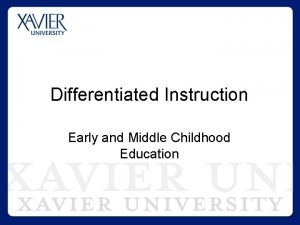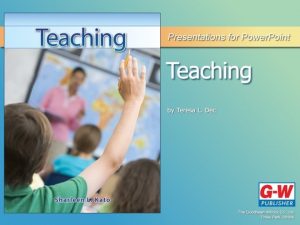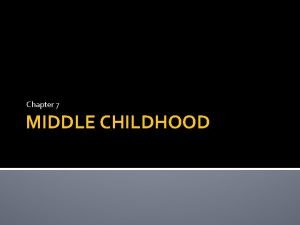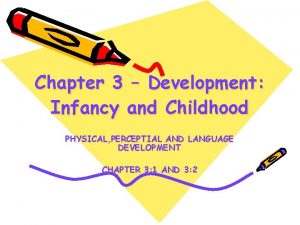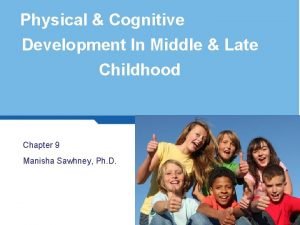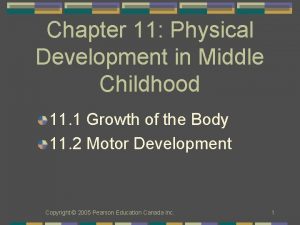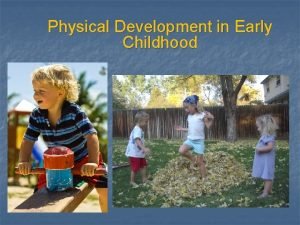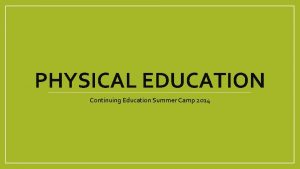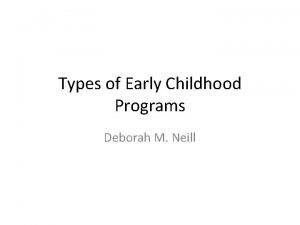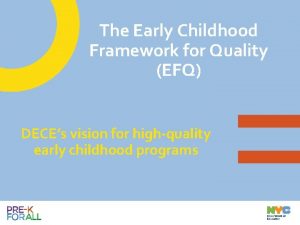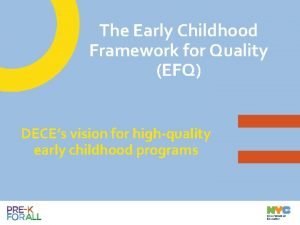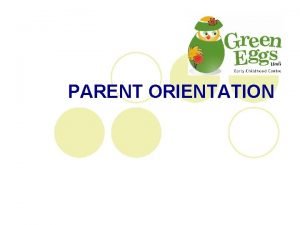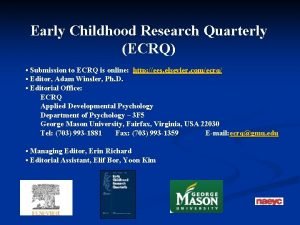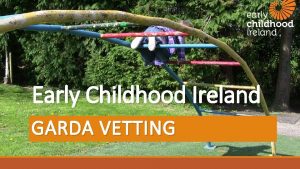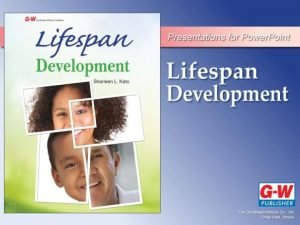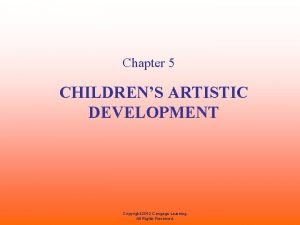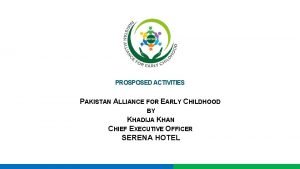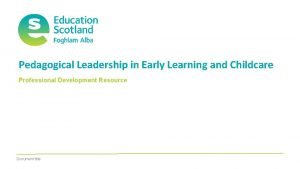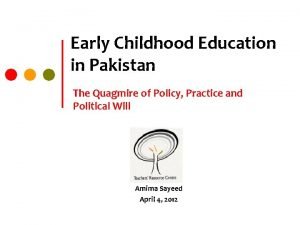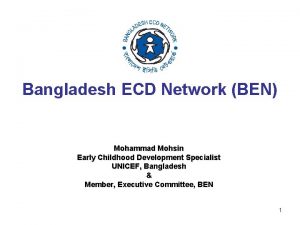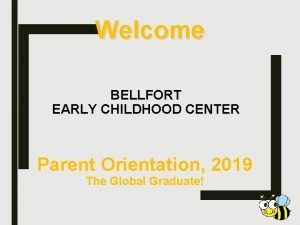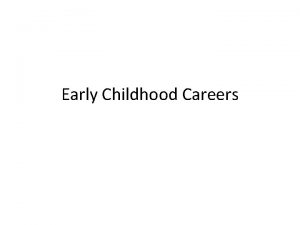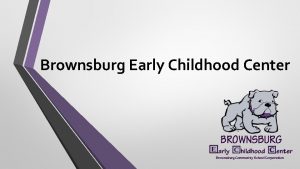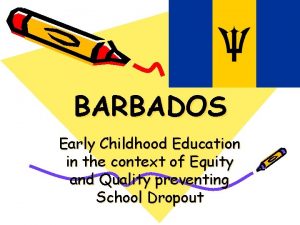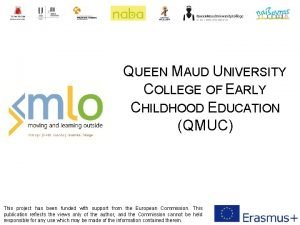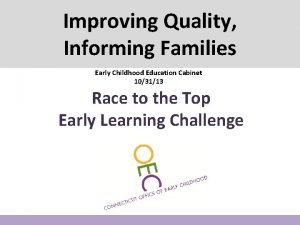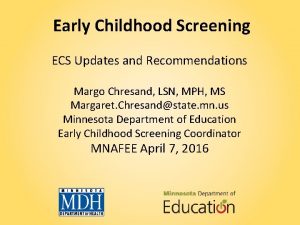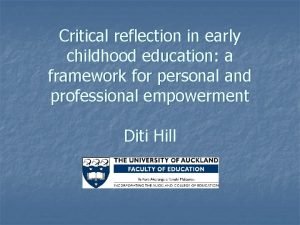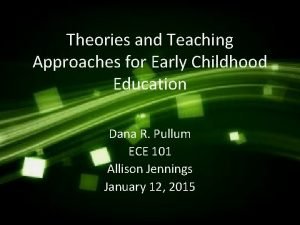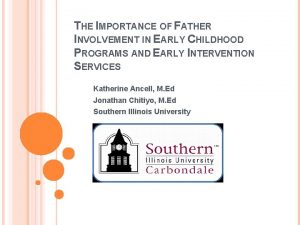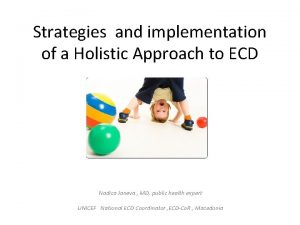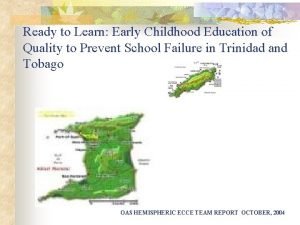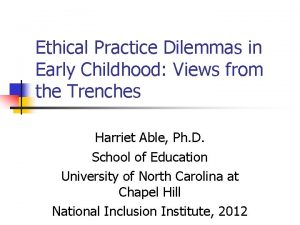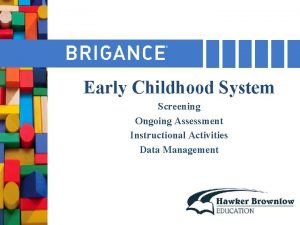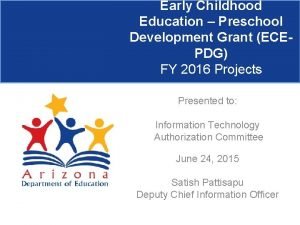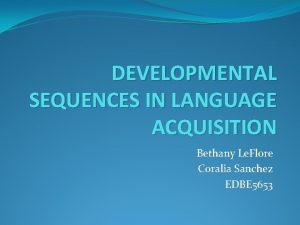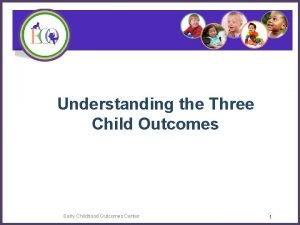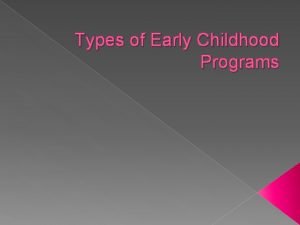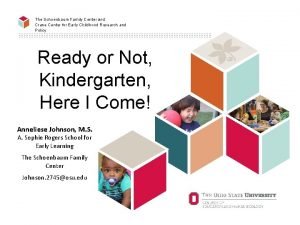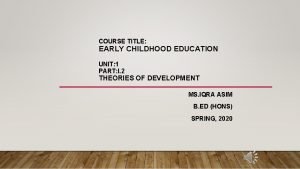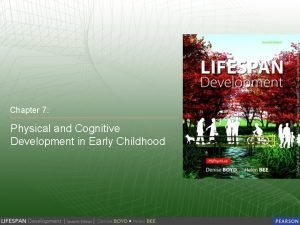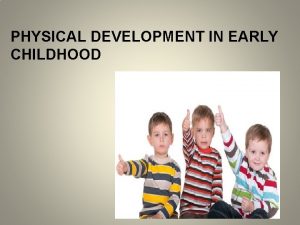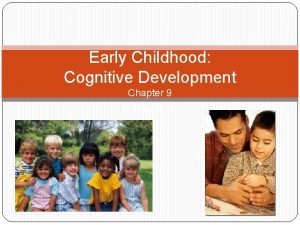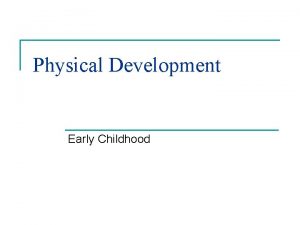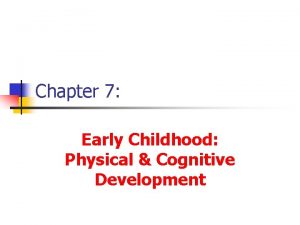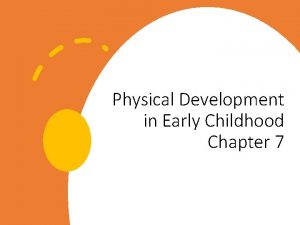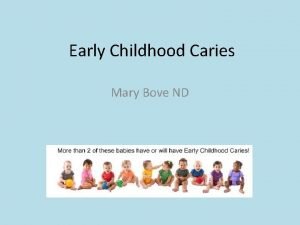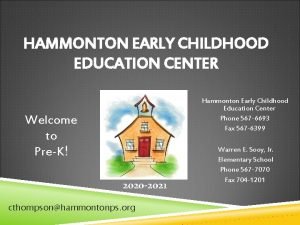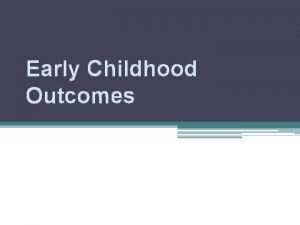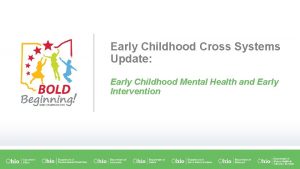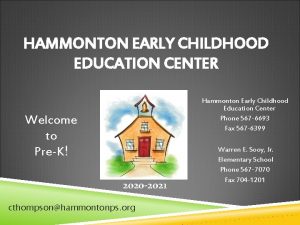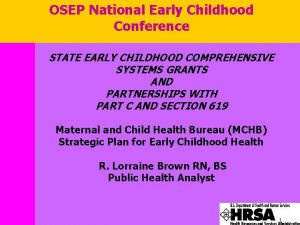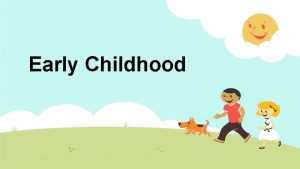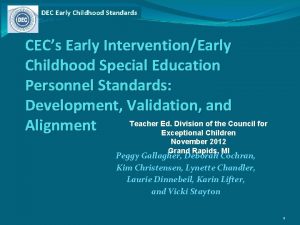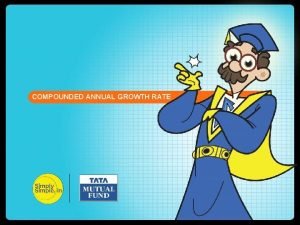Development in Early Childhood Physical Development Growth rate







































































- Slides: 71

Development in Early Childhood

Physical Development • Growth rate slows in early childhood but it is still the most obvious physical change • Girls are only slightly smaller and lighter than boys during these years • Heads are still somewhat large for their bodies • Body fat also shows a slow, steady decline – Girls have more fatty tissue than boys; boys have more muscle tissue (c) 2008 The Mc. Graw-Hill Companies, Inc.

Variations in Growth • Growth patterns vary individually • Much of the variation is due to heredity • Environmental experiences are also involved – urban, middle-socioeconomic-status, and firstborn children tend to be taller than rural, lower-SES, and later-born children – African-American children are taller than white children (Meredith, 1978) (c) 2008 The Mc. Graw-Hill Companies, Inc.

Brain and Nervous System Development • Continued myelinization, blooming and pruning • Development in the prefrontal cortex enables rapid development in selfcontrol, planning • Left hemisphere growth enables continued rapid language development • Development of the hippocamupus enables memory development

(c) 2008 The Mc. Graw. Hill Companies, Inc.

Motor Skills • Cerebellum and corpus collosum development combine with practice to promote motor development • Gross motor – Many new skills – Functional play and rough and tumble play

Fine Motor • Drawing 1. Scribbles 2. First representational forms (3 yrs) 3. More realistic drawings • Early printing – Develops gradually • • More concepts of print emerge starting around 4 Letter reversals common up through 2 nd grade

Piaget • Preschool children are active learners but have cognition distinct from that of adults and older children – Developmentally appropriate practices – Adaptation and organization of schemes • Assimilation • Accomodation • Equilibration

Pre-operational Stage • Children use symbolic thought capability developed in the final sensorimotor substage thought is intuitive rather than logical • Have not yet developed reversibility of operations (internalized actions) – Inversion/negation – the idea that an opposite action can undo an action – Compensation/reciprocity – another operation can compensate for the effects of the first

Pre-operational Stage 2 • High level of centration. Young children tend to focus on a single salient aspect of what is perceived in exclusion of all others – centration is most clearly evidenced in young children’s lack of conservation -- the awareness that altering an object’s or a substance’s appearance does not change its basic properties • Focus on states as opposed to transformations. – This is apparent in their difficulty with conservation tasks

Conservation • Preoperational children struggle with tasks in which they view a transformation and are asked to make a judgment on the end state



• Egocentrism -- inability to distinguish between one’s own perspective and someone else’s perspective • Animism -- the belief that inanimate objects have life-like qualities and are capable of action • Dual representation • Lack hierarchical classification • Around 4 begin to ask many questions as reasoning emerges and they seek to understand their world – Intuitive” because children seem sure about their knowledge and understanding but often can’t explain the reasoning

3 Mountains Task Adult Child

Implications for School Readiness and Transition • Since children learn by exploring and are active learners, provide opportunities for exploration – New materials to explore rotated regularly – Child centered environment and teaching • Children do not think like adults. Teaching must be geared to the developmental level and thinking of the child • Current research suggests that under certain circumstances children are more capable than Piaget hypothesized – With supports even young children are capable of some more logical thought – Animism and magical thinking most likely when children lack experience and knowledge

Vygotsky Sociocultural Theory • Learning occurs in the context of the social and cultural environment – Cognitive development occurs through interactions with others • Different societies provide children with different tools of intellectual adaptation – Chinese vs. English numeral system influences development of counting • Language promotes cognitive development and development of self regulation – External demands and reminders are internalized

Zone of Proximal Development • ZPD -- Vygotsky’s term for the range of tasks that are too difficult for the child to master alone but that can be learned with guidance and assistance of adults or more skilled children – lower limit of the ZPD is the level of skill reached by the child working independently – upper limit is the level of additional responsibility the child can accept with the assistance of an able instructor

Scaffolding 2 • Scaffolding -- the process of providing needed supports to increase a learner’s performance and reducing support as ability increases – when the student is learning a new task, the skilled person may use direct instruction – as the student’s competence increases, less guidance is given (Daniels, 2007) – Guided Participation – Rogoff’s extension of the concept of zone of proximal and scaffolding development to everyday activities • “involvement of individuals with others, as they engage in shared activities” (Rogoff et al 1993)

Guidance Relating to Play • Symbolic/pretend play allows children to explore roles and social norms, builds skills in planning, interpersonal skills, and higher cognitive skills • When adults and/or older children enter into the pretend play of young children the play achieves a higher cognitive level – Adults and older children tend to structure the play to be slightly above the level of the young child • Parents in postindustrial countries guide young children through verbal interaction. In less industrialized cultures children are better observers and parents guide more nonverbally

Language and Thought • According to Vygotsky (1962), children use speech not only for social communication, but also to help them solve tasks -- children use language to plan, guide, and monitor their behavior – language for self-regulation is called private speech – for Piaget, private speech is egocentric and immature – for Vygotsky, it is an important tool of thought during the early childhood years (John-Steiner, 2007; Wertsch, 2007)

Teaching Strategies Based on Vygotsky’s Theory • Assess the child’s ZPD • Use the child’s zone of proximal development in teaching • Use more-skilled peers as teachers • Monitor and encourage children’s use of private speech • Place instruction in a meaningful context

Implications for School Readiness and Transition • Strong focus on interactions between individuals • Focus on scaffolding as sensitive teaching to lead children to the next level • Parent involvement is actively facilitated and encouraged • Recognition that there may be several paths to cognitive development – Sensitivity to cultural diversity • Focus on play and everyday activities


Executive Functions • A set of higher cognitive abilities that control and regulate other behaviors and abilities relating to independent goaldirected behavior • Executive functions (EF) show positive relationships with academic outcomes, social skills, and self-regulation and negative relationships with behavior problems in children • Recent research suggests that EF can be enhanced, and that this can lead to improved outcomes

Executive Functions • Effortful Control- Focusing attention, inhibitory control • Working memory- ability to hold and manipulate ideas in the mind • Flexibility –Usually cognitive flexibility

Neuroscience • Prefrontal cortex is active during EF tasks, • Differential structure in ADHD patients and others with disorders involving EF • Link between alcohol, EF development, and EF functioning • Development of EF related to brain development • EF areas of the brain are most active when processing new material and experiences becoming less active as behavior becomes more familiar and automatic

Implications for School Readiness • Structured curriculum that promotes development of EF has been associated with cognitive gains – Tools of the Mind curriculum has been associated with gains in EF • Use of concrete external aids to memory and self control • Focus on play higher cognitive level as opposed to free play

Information-Processing Approach • Attention -- the focusing of cognitive resources • Memory -- the retention of information over time • Control of attention – Salient versus relevant dimensions – Planfulness


Memory • Short-term memory -- individuals retain information for only about 30 seconds – using rehearsal (repeating information after it has been presented), we can keep information in short-term memory for a much longer period – older children are better able to rehearse – speed and efficiency of processing information are important – memory becomes more accurate

Factors Influencing Accuracy of Memory • Susceptibility to misleading or incorrect post-event information • Individual differences in suggestibility • Interviewing techniques can produce distortions – suggestible not just about peripheral details but also about the central aspects of an event (Ghetti & Alexander, 2004) (Crossman, Scullin, & Melnyk, 2004; Gilstrap & Ceci, 2005) (Bruck, Ceci, & Hembrooke, 1998)

Theory of Mind • Awareness of one’s own mental processes and the mental processes of others • Has roots or beginnings in joint attention, gestures, and social referencing and a strong influence on perspective taking and social ability • Children’s theory of mind changes as they develop through childhood (Harris, 2006) (Flavell, Miller, & Miller, 2002)

Theory of Mind • Age 2 - 3, children begin to understand three mental states: – perceptions – emotions – desires • Age 4 - 5, they come to understand that the mind can represent objects and events accurately or inaccurately – they realize that people can have false beliefs -- beliefs that are not true

Theory of Mind: Beyond age 5 • Not until middle and late childhood do children see the mind as an active constructor of knowledge or processing center • Then they can move from understanding that beliefs can be false to realizing that the same event can be open to multiple interpretations (Flavell, Green, & Flavell, 2000) (Carpendale & Chandler, 1996)

Interventions • High quality preschool interventions for at-risk children can promote resilience – Enhance cognitive and socioemotional development – Prevent referral to special education, behavioral problems and school dropout – Best interventions are multifaceted • involve family, medical, social services and dental, etc.


Social and Emotional Development

Erikson Initiative • Children use their developing skills to make things happen – Motor – Cognitive – Language • New sense of purpose • Explore an expanding social world • Governed by developing conscience – Superego Guilt • Initiative can bring guilt as well as rewards – Too much guilt can be a problem • Responses can create a sense of Guilt and self-doubt – Harshly punitive – Overly critical – Rejecting Primarily parents but others as well

Emotional development • Awareness of self is linked to the ability to feel an expanding range of emotions – Still confused by mixed emotions and some complex emotions – Increase in the experience of self conscious emotions such as guilt and pride • Young children describe the self with many material characteristics, such as size, shape, and color • About 4 to 5 years of age, they begin to include psychological traits and emotion terms in their own self-descriptions • Important changes in emotional development: increased ability to talk about one’s own and others’ emotions – increase the number of terms they use to describe emotions

Emotion-Coaching and Emotion-Dismissing Parents • Emotion-coaching parents monitor their children’s emotions, view their children’s negative emotions as opportunities for teaching, assist them in labeling emotions, and coach them in how to deal effectively with emotions • Emotion-dismissing parents view their role as to deny, ignore, or change negative emotions • Important in the development of self understanding, empathy, and morality • Emotion coaching is associated with enhanced selfregulation, social skills, and moral development

Emotion and Peer Relationships • Emotions regulation and understanding plays a strong role in determining the success of a child’s peer relationships, esp. emotion regulation – moody and emotionally negative children experience rejection by their peers – positive children are more popular • Some young children are better than others at understanding what people are feeling and what they desire – Young children’s theory of mind includes understanding that other people have emotions and desires – About 4 to 5 years, they begin to perceive others in terms of psychological traits

Play

Types of Play -Social Nonsocial Activity Solitary Play Onlooker behavior Parallel Plays near other children with similar materials, but does not try to influence them • Declines across early childhood Social Interaction • Associative Play • separate activities but exchange toys and comment on each other’s activities • Cooperative play • More advanced interaction in which children work together toward common goals, such as acting out a pretend scenario

Types of Play- Cognitive Category Description Examples Functional Play (Sensorimotor and practice play) Simple repetitive movements Jumping, running, done for pleasure moving, a car back and (senorimotor play) or skill forth, development (practice play Constructive Play Creating or constructing something Building a block building, drawing, puzzles Pretend Play Acting out observed or imaginary roles • Appears by 2 and increases throughout early childhood Playing school, house, story or TV characters, cops and robbers, etc.

Early Friendships • Based on proximity and playing together – Someone who plays with you is your friend • Friendships change frequently but do provide social support and opportunities to practice and learn social skills

Gender

(c) 2008 The Mc. Graw-Hill Companies, Inc.

Gender and Aggression

Gender • Gender -- social and psychological dimensions of being male or female • Gender identity -- sense of being male or female • Gender roles -- sets of expectations that prescribe how females or males should think, act, and feel – preschool children act in ways that match their culture's gender roles and exhibit a sense of gender identity

Gender • Gender identity and gender roles strengthen over the preschool years – Boys engage in more active and rough and tumble play – Girls most often initiate separating out from the boys • Peers extensively reward and punish gender behavior – peers often reject children who act in a manner that is characteristic of the other gender • Gender based on roles, activities, and appearance – Can be quite rigid even if parents model less rigid roles

Social Theories of Gender Development • Social role theory -- contrasting roles of women and men • Psychoanalytic theory of gender -Freud’s view -- preschool child develops a sexual attraction to the opposite-sex parent – Oedipus (for boys) or Electra (for girls) complex • Social cognitive theory of gender -by observing and imitating and through being rewarded and punished (Alice Eagly, 2001) (Bussey & Bandura,

Gender Schemas and Behavior

Parental Influence on Gender Development • By action and by example, parents influence their children’s gender development – cultures around the world give mothers and fathers different roles – Mothers’ Socialization Strategies -- mothers socialize their daughters to be more obedient and responsible – Fathers’ Socialization Strategies -- fathers show more attention to sons than daughters, engage in more activities with sons, and put forth more effort to promote sons’ intellectual development – Parents enforce gender roles, esp. with sons (Grusec & Davidov, 2007)

Moral Development, Social Skills, Aggression and Parenting

Agression • Proactive (Instrumental) – fulfills a need or desire • Reactive (Hostile) – angry, defensive, meant to hurt • Physical • Verbal • Relational • Influences include media, family, and childcare/preschool

Parental Influences on Early Peer Relations Direct • Arrange informal peer activities • Guidance on how to act toward others • • Indirect Secure attachment Emotionally expressive, sensitive communication • Cooperative play

Characteristics of Good Models of Moral Behavior • Warmth and responsiveness • Competence and power • Consistency between words and behavior

Characteristics of Child-Rearing Styles Acceptance Involvement Control Autonomy Authoritative High Authoritarian Low High Low Permissive High Too low or too high Low High Uninvolved Low Low Indifference Adaptive Appropriate

Effective Parenting • Prevent Misbehavior – Set clear guidelines and expectations – Set consistent routines – Minimize demands when children are stressed, tired, hungry, etc. – Develop a warm relationship – Coach, model and reward appropriate behavior • Inductive discipline –helping a child to understand the effects of their misbehavior on others and correct the harm they have caused – Associated with positive moral development • Punish mildly, consistently, and sparingly – Effectiveness declines and negative effects increase with harshness and inconsistency and greater frequency • Use reasoning and explanations

(c) 2008 The Mc. Graw-Hill Companies, Inc.

Types of Child Maltreatment • Physical abuse – the infliction of physical injury • Child neglect – failure to provide for the child’s basic needs • Sexual abuse – fondling a child’s genitals, intercourse, incest, rape, sodomy, etc. • Emotional abuse – psychological/verbal abuse/mental injury – acts/omissions that have caused, or could cause, serious behavioral, cognitive, or emotional problems

Consequences of Abuse • Poor emotion regulation, attachment problems, problems in peer relations, difficulty in adapting to school, and other psychological problems such as depression and delinquency • Difficulty in establishing and maintaining healthy intimate relationships • As adults, they are at higher risk for violent behavior toward other adults, as well as for substance abuse, anxiety, and depression (Cicchetti & Toth, 2005, 2006) (Minzenberg, Poole, & Vinogradov, 2006) (Shea & others, 2005)

Prevention of Maltreatment • In a recent study, two treatments were effective in reducing child maltreatment: – home visitation that emphasized improved parenting, coping with stress, and increasing support for the mother – parent-infant psychotherapy that focused on improving maternal-infant attachment (Cicchetti, Toth, and Rogosch, 2005) • Reduce parent stress

Divorce

Consequences of Divorce • Children in divorced families are more likely to – have academic problems – show externalized problems (such as acting out and delinquency) and internalized problems (such as anxiety and depression) – have less competent intimate relationships – drop out of school – become sexually active at an early age – take drugs – have low self-esteem – A majority of children in divorced families do not have significant adjustment problems (Hetherington, 2005, 2006; Huurre, Junkkari, & Aro, 2006) (Conger & Chao, 1996) (Barber & Demo, 2006)

Divorce Adjustment • When divorced parents’ relationship with each other is harmonious and when they use authoritative parenting, the adjustment of children improves • Children who are socially mature and responsible, who show few behavioral problems, and who have an easy temperament are better able to cope • Children with a difficult temperament often have problems in coping with their parents’ divorce (Clarke-Stewart & Brentano, 2006; Walper Beckh, 2006) (Hetherington, 2005, 2006) (Hetherington, 2000)

Socioeconomic Issues of Divorce • Custodial mothers experience the loss of about one-fourth to one-half of their pre-divorce income • This income loss for divorced mothers is accompanied by increased workloads, high rates of job instability, and residential moves to less desirable neighborhoods with inferior schools • Custodial fathers have a loss of only one-tenth of their pre-divorce income (Sayer, 2006) (Emery, 1994)

Guidelines for Communicating with Children about Divorce • Explain the separation • Explain that the separation is not the child’s fault • Explain that it may take time to feel better • Keep the door open for further discussion • Provide as much continuity as possible (Galinsky & David, 1988)

What is going on with this child?

“Look at my snowlady!” • Teacher’s perspective – Who knows what she’s thinking, nothing to worry about. “Please hold your snowman with the stick at the bottom for our song” • Positive Approach To Learning? – Flexibility, creativity, initia tive and reasonable cooperation (she did hold it as asked) – or noncompliance with instructions
 Growth is defined as an increase in
Growth is defined as an increase in Physical development in early childhood
Physical development in early childhood Cognitive development in childhood
Cognitive development in childhood Early middle childhood
Early middle childhood Fine motor skills development in early childhood
Fine motor skills development in early childhood Psychosocial development in early childhood
Psychosocial development in early childhood Language development in early childhood
Language development in early childhood Early childhood is __________ for language learning
Early childhood is __________ for language learning Biosocial development in early childhood
Biosocial development in early childhood Early childhood development with differentiated instruction
Early childhood development with differentiated instruction Middle childhood growth and development
Middle childhood growth and development Physical development in middle childhood
Physical development in middle childhood Internally programmed growth of a child
Internally programmed growth of a child Late childhood
Late childhood Physical development in middle childhood chapter 11
Physical development in middle childhood chapter 11 Physical development in middle childhood
Physical development in middle childhood Late childhood cognitive development
Late childhood cognitive development Module 46 infancy and childhood physical development
Module 46 infancy and childhood physical development Non physical fences example
Non physical fences example Reflective and relativistic thinking
Reflective and relativistic thinking Early adulthood stage
Early adulthood stage Labouvie-vief pragmatic thought
Labouvie-vief pragmatic thought Summer camp 2014
Summer camp 2014 Three types of early childhood programs
Three types of early childhood programs Chapter 2 types of early childhood programs
Chapter 2 types of early childhood programs Nyc doe efq
Nyc doe efq Efq
Efq Suny pdp
Suny pdp Green eggs early childhood centre
Green eggs early childhood centre Early childhood directorate
Early childhood directorate Leonard di vinci
Leonard di vinci Trends in early childhood education
Trends in early childhood education Ecrq
Ecrq Garda vetting form early childhood ireland
Garda vetting form early childhood ireland Chapter 7 early childhood ages 3 through 5
Chapter 7 early childhood ages 3 through 5 Kellogg's developmental stages of art for early childhood
Kellogg's developmental stages of art for early childhood Amelia earhart parents names
Amelia earhart parents names Prosposed
Prosposed Leadership styles in childcare
Leadership styles in childcare Isaac newton early life and education
Isaac newton early life and education Eminem early childhood
Eminem early childhood Ece in pakistan
Ece in pakistan Early childhood education in bangladesh
Early childhood education in bangladesh Bellfort ecc
Bellfort ecc Associates in early childhood education jobs
Associates in early childhood education jobs Becc brownsburg
Becc brownsburg Attainment targets barbados
Attainment targets barbados Queen's university early childhood education
Queen's university early childhood education Kentucky governor's office of early childhood
Kentucky governor's office of early childhood Connecticut early childhood education cabinet
Connecticut early childhood education cabinet Early childhood screening rochester mn
Early childhood screening rochester mn Smyth reflection model
Smyth reflection model First sad memory of the young jose
First sad memory of the young jose Flushing latchkey
Flushing latchkey Skinner's operant learning theory
Skinner's operant learning theory Father involvement activities
Father involvement activities Holistic approach in early childhood education
Holistic approach in early childhood education Swot analysis early childhood education
Swot analysis early childhood education Cosf examples
Cosf examples Ethical dilemmas in early childhood education
Ethical dilemmas in early childhood education Ongoing assessment early childhood
Ongoing assessment early childhood Early childhood education
Early childhood education Developmental sequences
Developmental sequences Early childhood outcomes center
Early childhood outcomes center Three types of early childhood programs
Three types of early childhood programs The crane center ohio
The crane center ohio Emily dickinson childhood
Emily dickinson childhood Bf skinner early childhood education
Bf skinner early childhood education Early cpr and early defibrillation can: *
Early cpr and early defibrillation can: * Physical changes during childhood
Physical changes during childhood Monocots eudicots
Monocots eudicots Carothers equation
Carothers equation

